April 1943
| << | April 1943 | >> | ||||
|---|---|---|---|---|---|---|
| Su | Mo | Tu | We | Th | Fr | Sa |
| 1 | 2 | 3 | ||||
| 4 | 5 | 6 | 7 | 8 | 9 | 10 |
| 11 | 12 | 13 | 14 | 15 | 16 | 17 |
| 18 | 19 | 20 | 21 | 22 | 23 | 24 |
| 25 | 26 | 27 | 28 | 29 | 30 | |
The following events occurred in April 1943:
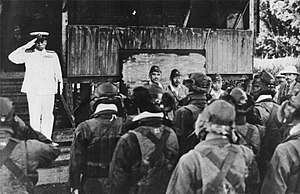
April 18, 1943: Japan's Admiral Yamamoto killed when Americans discover and shoot down his airplane
.jpg)
April 20, 1943: Jefferson Memorial dedicated on Jefferson's 200th birthday

April 3, 1943: Shipwreck survivor Poon Lim rescued after 131 days adrift
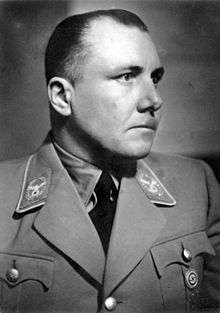
April 12, 1943: Martin Bormann designated as Hitler's second-in-command
April 1, 1943 (Thursday)
- SIGSALY, referred to as the X System vocoder or "Green Hornet", went into operation for use in secure phone conversations between U.S. President Franklin D. Roosevelt and U.K. Prime Minister Winston Churchill. The new system, developed by AT&T's Bell Labs, encrypted speech into electronic signals that could be transmitted at the rate of 1,551 bits per second, and decrypted it at the other end, permitting the two wartime leaders to talk to each other without being understood by wiretappers.[1]
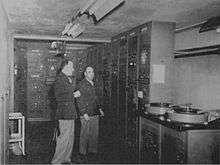 Britain's SIGSALY terminal
Britain's SIGSALY terminal
The terminals for transatlantic calls were at The Pentagon in Washington, D.C. and in the basement of Selfridges department store in London.
- In the Second Battle of Sedjenane, Allied forces retook the Tunisian town of Sedjenane on the railway line to Mateur and the port of Bizerta.
- Japanese forces launched Operation I-Go, an aerial counter-offensive in the Pacific.
- The Royal Air Force marked its 25th anniversary by presenting Churchill with honorary wings. "I am honoured to be accorded a place, albeit out of kindness, in that comradeship of the air which guards the life of our island and carries doom to tyrants, whether they flaunt themselves or burrow deep," Churchill stated.[2]
- The Italian destroyer Lubiana was either sunk or stranded off the Tunisian coast and declared a total constructive loss.
April 2, 1943 (Friday)
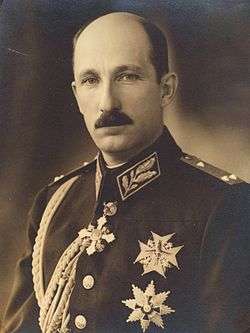
King Boris III
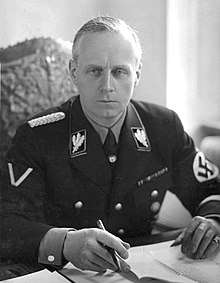
von Ribbentrop
- On a visit to Germany, King Boris III of Bulgaria told German Foreign Minister Joachim von Ribbentrop that the 25,000 Jews in Bulgaria would not be turned over to German control, despite the alliance between the two Axis powers. At most, the King said, the Bulgarian government might intern its Jewish citizens in camps under Bulgarian control.[3]
- The German submarine U-124 was shelled and sunk in the Atlantic Ocean west of Oporto, Portugal by British warships.
- Born: Larry Coryell, American jazz fusion guitarist, in Galveston, Texas (d. 2017)
April 3, 1943 (Saturday)
- A riot in Wellington, New Zealand between American servicemen and New Zealand servicemen and civilians known as the Battle of Manners Street occurred when some of the American servicemen refused to allow Māori soldiers from entering the Allied Services Club. Dozens of people were injured but news of the riot was censored at the time.
- Shipwrecked steward Poon Lim was rescued by Brazilian fishermen after being adrift for 131 days as the sole survivor of a British merchant ship, the SS Benlomond, which had been torpedoed on November 29, 1942.[4]
- Born: Richard Manuel, Canadian born pop musician for The Band; in Stratford, Ontario (committed suicide 1986)
- Died: Conrad Veidt, 50, German-born film actor known for (Casablanca)
April 4, 1943 (Sunday)
- Lady Be Good, an American B-24 bomber became lost over the North African desert after completing a bombing raid in Italy, ran out of gas, and crashed after its crew parachuted to safety. The nine member crew died of thirst, one by one, over the next eight days. For nearly 16 years, Lady Be Good would remain missing until its discovery on February 27, 1959. The bodies of the men would be found almost a year after that, on February 11, 1960.[5]
- William Dyess was able to escape from a Japanese prisoner of war camp in the Philippines along with nine other men, and to make his way through the jungle and to a ship that transported him to Australia. Once free, Dyess would be able to reveal to the world the atrocities of the Bataan Death March that had taken place after U.S. and Philippine forces surrendered on April 9, 1942.[6]
- An American B-25 bomber on a training mission went down in Lake Murray in South Carolina. The entire crew was rescued by a boater on the lake, but the B-25 sank to the bottom of the lake for the next 62 years, finally being raised on September 19, 2005 in nearly perfect condition.[7]
- German radio announced that three former imprisoned leaders had been turned over by the government of Vichy France, to Germany, in order to stop "establishment of a counter-government" [8] . Former Prime Ministers Édouard Daladier and Léon Blum, along with the former French Army commander in chief, General Maurice Gamelin, had been held in custody in France since shortly after the 1940 surrender, and would be sent to Buchenwald concentration camp until the end of the war.
- Born: Mike Epstein, American MLB baseball player nicknamed "SuperJew"; in the Bronx
- Died: Raoul Laparra, 67, French composer of the opera La Habanera; in an American air raid on Paris
April 5, 1943 (Monday)
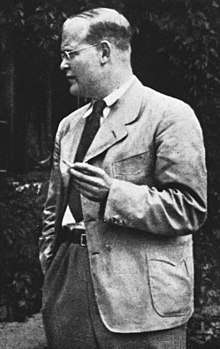
Pastor Bonhoeffer
- Lutheran pastor Dietrich Bonhoeffer was arrested at the headquarters of the German military intelligence (the Abwehr) by the Nazi secret police (the Gestapo) along with lawyer Hans von Dohnanyi, and both were found to have incriminating materials in their possession, showing cooperation with the enemy in Britain.[9] Adolf Hitler would order the execution of Bonhoeffer, Dohnanyi, and the Abwehr director, Admiral Wilhelm Canaris, on April 9, 1945, less than a month before the conquest of Germany.
- The German submarine U-635 was sunk in the North Atlantic by a B-24 of No. 120 Squadron RAF.
- The Japanese submarine Ro-34 was sunk off the Russell Islands by American destroyers O'Bannon and Strong.
- American bomber planes bombed the town of Mortsel in Belgium. The target was a local factory in which German fighter planes were being repaired. However, only four out of 216 bombs that were dropped hit the target, while the others destroyed most of the town of Mortsel, killing 936 civilians. [10]
- Born: Max Gail, American television actor who portrayed Wojo Wojciehowicz, on Barney Miller; in Detroit
April 6, 1943 (Tuesday)
- The Battle of Wadi Akarit began in Tunisia.
- The German submarine U-632 was sunk in the Atlantic Ocean by a B-24 of No. 86 Squadron RAF.
- The Little Prince, a children's book by Antoine de Saint-Exupéry, was published. Saint-Exupéry would join the French Army later in the month, and would disappear the next year after his airplane was shot down in combat.[11]
- Five members of the U.S. Army Air Forces were rescued after having been marooned on an icecap in Greenland for almost five months. The men had been on a B-17 bomber that made a crash landing while searching for another lost plane, but were kept alive with supplies dropped by Colonel Bernt Balchen, an Arctic explorer and aviator.[12]
April 7, 1943 (Wednesday)
- Adolf Hitler and Benito Mussolini began a four-day meeting at Schloss Klessheim near Salzburg. Mussolini was in poor health and would spend most of the conference listening silently to Hitler's long rambling monologues; an attempt by Mussolini to bring up the possibility of making peace with the Soviets was swiftly rebuffed.[13]
- The British government published a plan drawn up by John Maynard Keynes for a postwar economy. The plan proposed an international monetary fund which could help any nation out of temporary financial difficulties. In return, that country would have to adopt policies aimed at restoring stability.[14]
- The Battle of Wadi Akarit ended in Allied victory.
- The American destroyer Aaron Ward was bombed and sunk in Ironbottom Sound by Japanese aircraft.
- The German submarine U-644 was torpedoed and sunk in the Norwegian Sea by the British submarine Tuna.
- Bolivia declared war against the Axis powers, becoming the 33rd nation to enter World War II on the side of the Allies.[15]
- Died: Alexandre Millerand, 84, President of France 1920–1924
April 8, 1943 (Thursday)
- The Japanese decided to answer their logistic needs by building a new railway in northern Burma using forced labour.[16]
- The German submarine U-733 sank in a collision with a patrol boat at Gotenhafen. U-733 would be raised, repaired and returned to service.
- The Detroit Red Wings defeated the Boston Bruins 2-0 to sweep the 1943 Stanley Cup Finals in four games.[17]
- The 1943 NFL draft was held in Chicago. The Detroit Lions selected running back Frank Sinkwich of the University of Georgia as the #1 overall pick.
- Born: Michael Bennett, American choreographer and director (A Chorus Line), and winner of seven Tony Awards; as Michael Bennett DiFiglia in Buffalo, New York (died of AIDS in 1987)
- Died:
- Harry Baur, 62, French character actor, killed after being tortured by the Gestapo in Berlin
- Richard Sears, 81, seven-time U.S. tennis champion, 1881–1887
April 9, 1943 (Friday)
- Liquidation of the Jews in the Zborow ghetto in German-occupied Ukraine began, with the shooting of about 2,300 people on the first day.[18]
- The Japanese destroyer Isonami was torpedoed and sunk in the Banda Sea by the American submarine Tautog.
- The war film Edge of Darkness starring Errol Flynn and Ann Sheridan was released.
- Died: Philip Slier, 19, a Jewish Dutch typesetter whose letters about life in a Nazi forced labor camp would be discovered in 1997, was killed in the Sobibór extermination camp
April 10, 1943 (Saturday)
- Former American college football star Tom Harmon, who had joined the U.S. Army Air Corps, disappeared while flying over Surinam. The only member of his crew to survive a crash in bad weather, Harmon survived for seven days by drinking swamp water and eating rations, Harmon was able to make his way to Paramaribo and was able to rejoin his unit.[19]
- The Tunisian port of Sfax was captured from the Axis powers by the British Army, led by General Bernard Montgomery in the course of the North African Campaign. Sfax would then become the base for the Allied invasion of Sicily as the first stage of the Italian Campaign.[20]
- The Italian cruiser Trieste sank in port at La Maddalena, Sardinia after being hit by several bombs from American B-24s.
- Born: Margaret Pemberton, British romance and mystery author, as Margaret Hudson in Bradford
April 11, 1943 (Sunday)

The Piasecki PV-2
- Frank Piasecki made the first flight of his own Piasecki PV-2, only the second successful American helicopter. The PV-2 "featured the first dynamically balanced rotor blades", differing it from the Vought-Sikorsky VS-300, which had made its first free flight on May 13, 1940.[21]
- The British destroyer Beverley was torpedoed and sunk in the Atlantic Ocean by German submarine U-188.
- Born: Harley Race, American pro wrestling star, in Quitman, Missouri
- Died:
- Rufus Leonoir Patterson, Jr., 70, inventor and developer of tobacco manufacturing machinery
- James Hatsuaki Wakasa, 63, former chef from San Francisco and an internee at the Topaz War Relocation Center near Topaz, Utah. Wakasa, a Japanese-born American citizen, had been relocated to Utah as part of the Japanese American internment. He was shot and killed by a military policeman, Private Gerald B. Philpott, after venturing too close to the fence surrounding the camp. Philpott would be acquitted of any wrongdoing at a court-martial.[22]
April 12, 1943 (Monday)
- Martin Bormann was appointed as Secretary to the Führer, the second highest office in Nazi Germany.[23]
- The British War Office made its first report on the intelligence gathered concerning Germany's missile program, with the title "German Long-Range Rocket Development".[24]
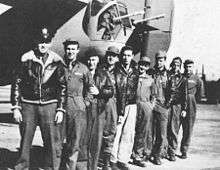
The crew of Lady Be Good; Co-pilot Toner is second from left
- Eight days after he and his crewmates were lost in the Libyan desert in the crash of Lady Be Good, co-pilot and U.S. Army 2nd. Lt. Robert Toner wrote the last entry in his journal: "No help yet, very cold nite". The diary, and Toner's body, would be found nearly 17 years later.[25]
- On Budget Day in the United Kingdom, Chancellor of the Exchequer Sir Kingsley Wood announced that the war had cost Britain a total of £13 billion to date and was costing £15 million per day. In the new financial year excess expenditure over revenue was estimated at £2,848,614,000.[26]
April 13, 1943 (Tuesday)
- Radio Berlin announced the discovery by Wehrmacht of mass graves of 10,000 Poles killed by the Soviets in the Katyn massacre.[27][28]
- In Washington, D.C., the thirty-second U.S. president, Franklin Roosevelt, dedicated the Jefferson Memorial on the bicentennial of the birth of the third American president, Thomas Jefferson.[29]
- Died: Oskar Schlemmer, 54, German painter, sculptor, designer and choreographer associated with the Bauhaus school
April 14, 1943 (Wednesday)
- The Commander of the 8th Japanese fleet broadcast a coded message concerning a tour of the fleet by the Naval Commander Admiral Isoroku Yamamoto to begin on April 18, probably in the high security code JN25 which Allied cryptanalysts had broken.[30][31][32]
- U.S. Senator Harry S. Truman of Missouri appeared as a speaker in Chicago at the "United Rally to Demand the Rescue of Doomed Jews", calling for the United States to respond directly to the Holocaust.[33]
- The Soviet Union reorganized its intelligence gathering system, setting up the People's Commissariat for State Security (NKGB, later the MGB) as a separate agency from the NKVD (later the KGB). Lavrentiy Beria remained in control of the NKVD, while Beria's assistant, Vsevolod Merkulov was named as the Director of the NKGB.[34] Both Beria and Merkulov, along with four other Beria loyalists, would be executed on December 23, 1953, nine months after the death of Joseph Stalin.
- The German submarine U-526 struck a mine and sank in the Bay of Biscay.
- Four inmates of Alcatraz Federal Penitentiary attempted to escape from the prison, making it to the water when the tower guards opened fire on them. Two were killed and one hid until he was found three days later, but the body of the fourth, James Boarman, was never found.[35]
April 15, 1943 (Thursday)
- The U.S. Army established its first overseas "V-Mail" station in order to use the "Victory Mail" process to get letters to and from servicemen. The facility, based in Casablanca, Morocco, used the process of photographing, on microfilm, pre-screened letters to the United States so that mail could be transported to the U.S. with a minimum of space. V-Mail letters from the U.S. to servicemen were also put on microfilm, and enlarged prior to delivery.[36]
- The State Bank of Ethiopia was created as the new central bank in the African nation, which had recently been liberated from Italian control. The State Bank also had the authority to print banknotes and mint coins. It would be replaced in 1964 by the National Bank of Ethiopia.[37]
- The Fountainhead, a novel by Ayn Rand, was released by Bobbs-Merrill and would go on to become her first bestseller.[38]
- The Sino-American Special Technical Cooperative Agreement was signed between the United States and the Republic of China, creating the Sino-American Cooperative Organization (SACO).[39]
- The Italian submarine Archimede was sunk off Brazil by an American Consolidated PBY Catalina.
April 16, 1943 (Friday)
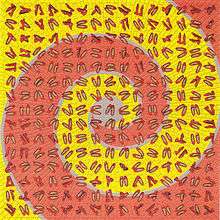
An LSD blotter blotter paper [40]

Discoverer Hoffmann[41]
- At the Sandoz laboratories in Basel, Switzerland, biochemist Albert Hofmann accidentally ingested the drug LSD for the first time in history, and recorded the details of his experience.[42]
- The Battle of the Cigno Convoy was fought southeast of Marettimo island in the Mediterranean Sea. The result was an Italian victory as the British destroyer Pakenham was sunk while the Italians lost one torpedo boat in return.
- In Mexico, Ramón Mercader, a.k.a. Jacques Monard, was sentenced to 20 years in prison for assassinating Leon Trotsky with an ice pick in 1940.[14]
- Born: Krzysztof Wodiczko, Polish-born industrial designer and media artist, in Warsaw
April 17, 1943 (Saturday)
- The United States War Manpower Commission, headed by Paul V. McNutt, issued an order that prevented 27,000,000 civilian employees from changing jobs. Basically, an employee in an "essential activity" could not be hired to a job that was not essential to the war effort, unless he or she remained unemployed for at least 30 days. Likewise, a vital employer could not offer a higher wage rate to lure a worker from another vital employer without 30 days between jobs. Business owners and employees who violated the regulation were subject to a fine of up to $1,000 per violation and a year in prison. The manpower "freeze" was to remain in effect until the end of the war.[43]
- A fleet of 117 B-17 bombers of the U.S. Eighth Army Air Force raided Bremen.[16]
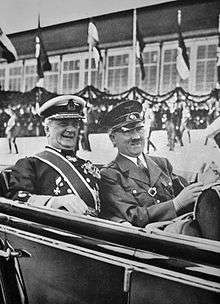
Horthy and Hitler in 1938
- At a meeting in Salzburg with German Führer Adolf Hitler and Foreign Minister Ribbentrop, Admiral Miklós Horthy, the Regent and Head of State for the Kingdom of Hungary, refused a personal request by Germany to deliver 800,000 Hungarian Jews to the Nazis, despite the alliance between the two as Axis powers.[3]
- The German submarine U-175 was depth charged and sunk in the Atlantic Ocean by the American coast guard cutter Spencer.
- Luftwaffe dive bombers raided the North African port of Algiers. Fifteen Catholic Religious Sisters perished at their prayers as the bombs demolished an orphanage. The fifteen who died and three sisters who were severely wounded remained behind to pray when the raid started while other sisters led sixty orphans from the building to the safety of an air raid shelter. Among the victims was Mother Superior Marie Duval, who had been at the convent for 31 years. General Henri Honore Giraud, civil and military commander-in-chief of French North and West Africa, awarded Duval the French Legion of Honor posthumously, stating: "On April 17, 1943, she was a victim of German barbarism, as were fourteen of her sisters."[44]
April 18, 1943 (Sunday)
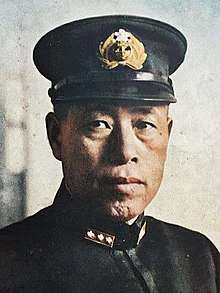
Isoroku Yamamoto
- Admiral Isoroku Yamamoto, the Commander-in-Chief of the Japanese Navy and the architect of the December 7, 1941, attack on Pearl Harbor, was killed when the plane that he was on was shot down by U.S. Army fighter pilot Rex T. Barber. American naval intelligence had intercepted and decoded a Japanese message that included the itinerary for an inspection tour that Yamamoto was making of the Solomon Islands. The body of Yamamoto, who was mortally wounded by Bougainville Island, was found the next day by a Japanese search party.[45]
- The British submarine Regent struck a mine and sank in the Strait of Otranto.
April 19, 1943 (Monday)
- Fourteen German citizens associated with the White Rose anti-Nazi resistance group are found guilty and promptly executed for crimes against the Nazi regime.[46]
- At 8:00 am, SS Polizeifuhrer Jürgen Stroop commenced the final destruction of the Warsaw Ghetto and breaking of the Warsaw Ghetto Uprising, with German SS troops fighting the Jewish resistance. The operation would not be completed until May 16.[47] The Jewish defenders would kill 16 Germans and wound 85.[48]
- The escape of 233 Belgian Jews from a train bound for Auschwitz was made possible by a raid by three members of the Belgian resistance movement [49]. The train was halted shortly after it had departed the concentration camp at Mechelen with 1,631 internees, bound for the Auschwitz concentration camp. Of the 233 who fled, 118 were able to get away. Another 89 were recaptured, and 26 were killed.
- Biochemist Albert Hofmann followed up his accidental experience of three days earlier by intentionally ingesting 250 µg of lysergic acid diethylamide in an attempt to bioassay the substance.[50]
- Winston Churchill announced in the House of Commons that restrictions on the ringing of church bells throughout Britain would be lifted now that the threat of German invasion had passed.[14]
- Operation I-Go ended inconclusively.
- Gérard Côté won the Boston Marathon.[51]
April 20, 1943 (Tuesday)
- In Tunisia, Bernard Montgomery approved an uncharacteristically aggressive series of small attacks against strongly defended Axis positions at Enfidha. Heavy Allied casualties resulted.[16]
- The RAF marked Hitler's 54th birthday by bombing Berlin and three other cities.[14] Hitler himself passed the day quietly at the Berghof.[52]
- Mamoru Shigemitsu, Japan's Minister of Greater East Asia, was selected by Prime Minister Tojo to be the new Japanese Minister for Foreign Affairs, replacing Masayuki Tani.[53]
- Born: John Eliot Gardiner, English conductor, in Fontmell Magna, Dorset
April 21, 1943 (Wednesday)
- The bombing of Aberdeen killed 98 civilians and 27 servicemen. The attack was the worst of 34 separate German air raids on the Scottish city.[54]
- Admiral Mineichi Koga became the new Commander of the Japanese Navy, succeeding the late Admiral Yamamoto.[55]
- Captain Frederick M. Trapnell became the first U.S. Navy aviator to fly a jet airplane, when he took up the Bell P-59 from the Muroc Army Air Field (now Edwards Air Force Base) in California. Colonel Laurence C. Craigie of the U.S. Army had flown the P-59 on October 2, 1942.[56]
- The American submarine Grenadier was bombed by Japanese aircraft in the Strait of Malacca and scuttled the next day.
- The British submarine Splendid was shelled and damaged off Corsica by German destroyer Hermes and was scuttled to prevent capture.
April 22, 1943 (Thursday)
- The final Allied attack on Tunisia began with the opening of the Battle of Longstop Hill.[57]
- The Battles of Bobdubi and Mubo began between Australian and Japanese forces in the Territory of New Guinea.
- Born: Louise Glück, American poet laureate, 2003–2004, in New York City
April 23, 1943 (Friday)
- SS Polizeifuhrer Jürgen Stroop carried out the order by Heinrich Himmler to burn down all of the buildings in the Warsaw Ghetto.[3][58]
- The Battle of Longstop Hill ended in British victory.
- The German submarines U-189 and U-191 were both lost to enemy action in the Atlantic Ocean, while U-602 went missing on patrol in the Mediterranean Sea.
- Born:
- Tony Esposito, ice hockey player and Hockey Hall of Fame inductee, in Sault Ste. Marie, Ontario, Canada
- Gail Goodrich, American basketball player and Basketball Hall of Fame inductee, in Los Angeles, California
- "Fighting Harada" (Masahiko Harada), Japanese professional boxer, world bantamweight champion 1965–1968, in Tokyo
- Hervé Villechaize, French television actor who portrayed "Tattoo" on Fantasy Island, in Paris (committed suicide 1993)
April 24, 1943 (Saturday)
- The Fire Department of New York (FDNY) responded to a fire on the munitions ship El Estero that threatened to destroy the port. The ship had been loading torpedoes at a pier used by the U.S. Army, caught fire, and began drifting after burning through the lines that tied it to the dock. The FDNY fireboat, Fire Fighter spent seven harrowing hours towing the ship away and then inundating with enough water to sink it. An explosion of the ship could have set off a chain reaction that would have blown up other ammunition ships, tanks of natural gas, gasoline and oil on the shore, and "the largest ammunition dump in the U.S.", located on the New Jersey shore. Twelve years later, an author would describe the event as "the night New York City almost blew up".[59]
- The British submarine Sahib was scuttled after being depth charged and damaged off Capo di Milazzo, Sicily by a Luftwaffe Junkers Ju 88.
- The German submarine U-710 was sunk in the North Atlantic by a B-17 of No. 206 Squadron RAF.
- Died:
- Kurt von Hammerstein-Equord, 64, German general
- Kenneth Whiting, 61, U.S. Navy Commander described as the "father of the aircraft carrier", died of a heart attack while hospitalized for pneumonia.
April 25, 1943 (Sunday)
- The German submarine U-203 was sunk off Cape Farewell, Greenland by British aircraft and the Royal Navy destroyer Pathfinder.
- Easter occurred on the latest possible date. The last time it had happened had been on April 25, 1886, and the next time will be on April 25, 2038.
- Born: James G. Mitchell, Canadian-born computer scientist, in Kitchener, Ontario
April 26, 1943 (Monday)
- The aircraft carrier USS Intrepid was launched from Newport News, Virginia, and would be commissioned on August 16.[60]
- The Easter Riots broke out at a manifestation by a Nazi party in Uppsala, Sweden.
- Born: Dominik Duka, Czech Roman Catholic priest and Archbishop of Prague, in Hradec Králové, in the German "Protectorate of Bohemia and Moravia" (now the Czech Republic
April 27, 1943 (Tuesday)
- The Battle of Hill 609 began between American and German forces in Tunisia.
- Because of German labor needs occasioned by World War II, Heinrich Himmler directed concentration camps to avoid killing those persons who were able to work, and to make it a priority to put to death "the mentally ill who could not work".[61]
- The German submarine U-174 was depth charged and sunk south of Newfoundland by an American Lockheed Ventura.
April 28, 1943 (Wednesday)
- SS Kamakura Maru, a Japanese troop ship that had been converted from the ocean liner Chichibu Maru, was torpedoed and sunk in the Pacific Ocean by the American submarine USS Gudgeon, with the loss of 2,035 of the 2,500 people on board.[62]
- British Commandos of No. 14 (Arctic) Commando began Operation Checkmate, a raid on shipping at Haugesund, Norway.
- Born:
- John O. Creighton, American astronaut on three missions, in Orange, Texas
- Jim Northrup, American Indian (Ojibway) humorist and author, in Cloquet, Minnesota (d. 2016)
April 29, 1943 (Thursday)
- The American freighter SS McKeesport was torpedoed and sunk by a German submarine, leading to a sea battle that continued over the next several weeks, during which 47 German U-boats were sunk.[63]
- The German submarine U-332 was depth charged and sunk in the Bay of Biscay by a B-23 of No. 224 Squadron RAF.
- Died: Canadian soldier August Sangret, 29, was hanged in London's Wandsworth Prison, after being convicted of killing his girlfriend Joan Wolfe, in what was called "The Wigwam Murder".[64]
April 30, 1943 (Friday)
- The British submarine HMS Seraph surfaced off of the coast of Spain, near Huelva, and dumped the body of "Major Martin" into the Mediterranean Sea as part of the Operation Mincemeat, to deceive German intelligence on plans for an Allied invasion of the continent.[65]
- The German submarine U-227 was depth charged and sunk north of the Faroe Islands by a Handley Page Hampden of No. 455 Squadron RAAF.
- Born: Frederick Chiluba, second President of Zambia (1991–2002), in Kitwe, Northern Rhodesia (now Zambia) (d. 2011)
gollark: Hence Spectre and Meltdown.
gollark: Lots of effort has gone into making current computers run C fast instead of just being as high-performance as possible.
gollark: Also, our hardware being optimized for it.
gollark: Wow, I was right!
gollark: Actually, it's fine, we can just email our Go programs off to Google and have them compile it for us.
References
- Manfred R. Schroeder, Computer Speech: Recognition, Compression, Synthesis (Springer, 2004) p108
- Churchill, Winston (2013). Onwards to Victory. RosettaBooks. ISBN 978-0-7953-3169-5.
- Richard J. Evans, The Third Reich at War, 1939–1945 (Penguin, 2010)
- "Chinese Steward Used Bent Nail To Fish During 131 Days Adrift", Gallup (NM) Independent, May 25, 1943, p1; "Torpedo Victim Spends 131 Days Alone on a Raft", Milwaukee Journal, May 25, 1943, p3
- Mario Martinez, Lady's Men: The Story of World War Ii's Mystery Bomber and Her Crew (Naval Institute Press, 1999); "Bodies of War Plane Crew Discovered in African Desert", Oakland Tribune, February 13, 1960, p1
- Eugene P. Boyt David L. Burch, Bataan: A Survivor's Story (University of Oklahoma Press, 2004) p xii
- Roger Manley and Mark Moran, Weird Carolinas: Your Travel Guide to the Carolinas' Local Legends and Best Kept Secrets (Sterling Publishing Company, 2007) p237
- "Blum, Others Held in Reich", Milwaukee Journal, April 5, 1943, p1
- John H. Waller, The Unseen War in Europe: Espionage and Conspiracy in the Second World War (I.B.Tauris, 1996) pp 308–309
- Richard Overy, The Bombers and the Bombed: Allied Air War Over Europe 1940-1945 (Penguin, 2014) p418
- Anita Silvey, Children's Book-a-Day Almanac (Macmillan, 2012) p96
- "Fliers, Stranded Five Months, Rescued by Heroic Efforts", Milwaukee Journal, May 4, 1943, p2
- Corvaja, Santi (2008). Hitler & Mussolini: The Secret Meetings. New York: Enigma Books. pp. 218–219. ISBN 978-1-929631-42-1.
- Mercer, Derrik, ed. (1989). Chronicle of the 20th Century. London: Chronicle Communications Ltd. p. 581. ISBN 978-0-582-03919-3.
- "Bolivia Joins War on Axis", Milwaukee Journal, April 7, 1943, p4
- Davidson, Edward; Manning, Dale (1999). Chronology of World War Two. London: Cassell & Co. pp. 149–150. ISBN 0-304-35309-4.
- "Wings Capture Stanley Cup — Mowers Shuts out Bruins Again, 2-0, to Clinch Playoff", Montreal Gazette, April 9, 1943, p16
- "Zborow", in The United States Holocaust Memorial Museum Encyclopedia of Camps and Ghettos, 1933–1945: Ghettos in German-Occupied Eastern Europe, Geoffrey P. Megargee, ed. (Indiana University Press, May 4, 2012) p849
- Bruce Madej, et al., Michigan: Champions of the West (Sports Publishing LLC, 1997) p97
- "Sfax", in Cities of the Middle East and North Africa: A Historical Encyclopedia Michael Richard, et al., eds. (ABC-CLIO, 2007) p333
- Walter J. Boyne, How the Helicopter Changed Modern Warfare (Pelican Publishing, 2011) p48, p86
- "Sentry Shoots Japanese At Utah Center", Salt Lake Tribune, April 13, 1943, p12; Jewel of the Desert: Japanese American Internment at Topaz, by Sandra C. Taylor (University of California Press, 1993)
- Jacques Delarue, The Gestapo: A History of Horror (Skyhorse Publishing, 2008) p337
- Norman Longmate, Hitler's Rockets: The Story of the V-2s (Skyhorse Publishing, 2009) p63
- "Desert Gives Up Its Secret", LIFE Magazine, March 7, 1960
- "Britain's Budget". The Central Queensland Herald. Rockhampton. April 15, 1943. p. 12.
- "Katyn Forest, Massacre in ", Encyclopedia of War Crimes and Genocide, Leslie Alan Horvitz and Christopher Catherwood, eds., (Infobase Publishing, 2009) p261
- Simon Berthon and Joanna Potts, Warlords: An Extraordinary Re-Creation of World War II Through the Eyes and Minds of Hitler, Churchill, Roosevelt, And Stalin (Da Capo Press, 2006) p181
- Edwin S. Gaustad, Sworn on the Altar of God: A Religious Biography of Thomas Jefferson (Wm. B. Eerdmans Publishing, 1996) pp 181–182; "Jefferson Shrine Dedicated By FDR", Miami Dalily News, April 13, 1943, p1
- David Kahn, The Codebreakers: The Comprehensive History of Secret Communication from Ancient Times to the Internet (Simon and Schuster, 1996) p595
- Robert C. Ehrhart, et al., Piercing the Fog: Intelligence and Army Air Forces Operations in World War II (Air Force History and Museums Program, 1996) pp 270–271
- Stephen Budiansky, Battle of Wits: The Complete Story of Codebreaking in World War II (Simon and Schuster, 2000) pp 319–320
- Michael J. Cohen, Truman and Israel (University of California Press, 1990) pp 36–37
- David E. Murphy, Sergei A. Kondrashev and George Bailey, Battleground Berlin: CIA Vs. KGB in the Cold War (Yale University Press, 1997) p29
- "This day in crime history". Nobody Move!. April 14, 2015. Retrieved February 21, 2016.
- "V-Mail", in 'Military Communications: From Ancient Times to the 21st Century Christopher H. Sterling, ed (ABC-CLIO, 2008) p489
- "Banking", in Historical Dictionary of Ethiopia David H. Shinn and Thomas P. Ofcansky, eds. (Scarecrow Press, 2004) pp 59–60
- "The Fountainhead from Notebook to Novel", by Shoshana Milgram, in Essays on Ayn Rand's The Fountainhead (Lexington Books, 2007) p3
- "Sino-American Cooperative Organization (SACO)", China at War: An Encyclopedia, Xiaobing Li, ed. (ABC-CLIO, 2012) p395
- attribution: William Rafti
- attribution: Stepan
- John Horgan, Rational Mysticism: Spirituality Meets Science in the Search for Enlightenment (Houghton Mifflin Harcourt, 2004) p141; Jan Dirk Blom and Iris E.C. Sommer, Hallucinations: Research and Practice (Springer, 2011) p308
- "FREEZE 27 MILLION TO JOBS", Chicago Sunday Tribune, April 18, 1943, p1
- "Prints and Photographs Online Catalog". Library of Congress.

- Patrick Degan, Flattop Fighting in World War II: The Battles Between American and Japanese Aircraft Carriers (McFarland, 2003) pp 140–142
- Wittenstein, George J., M.D., "Memories of the White Rose" (Part 4, Trial and Aftermath), 1979
- Moshe Arens, Flags Over the Warsaw Ghetto: The Untold Story of the Warsaw Ghetto Uprising (Gefen Publishing House, 2011) p318; Israel Gutman, The Jews of Warsaw, 1939–1943: Ghetto, Underground, Revolt (Indiana University Press, 1989) pp 364–365
- Paul Johnson, A History of the Jews (HarperCollins, 1988) p509
- "Escaping the train to Auschwitz", by Althea Williams and Sarah Ehrlich, BBC News Magazine, April 20, 2013
- Albert Hoffman, LSD: Mein Sorgenkind (Deutscher Taschenbuch Verlag, 1999)
- "Boston Marathon Yearly Synopses (1897–2013)". John Hancock Financial. Retrieved February 20, 2016.
- Seidler, Franz Wilhelm; Zeigert, Dieter (2004). Hitler's Secret Headquarters. Greenhill. p. 155. ISBN 978-1-85367-622-2.
- Carl Boyd, Hitler's Japanese confidant: General Ōshima Hiroshi and MAGIC intelligence, 1941–1945 (University Press of Kansas, 1993) p77
- "Aberdeen photographs show World War 2 destruction", by Rita Brown, Aberdeen Evening Express, January 29, 2010
- "The 'Z Plan' Story: Japan's 1944 Naval Battle Strategy Drifts into U.S. Hands", by Greg Bradsher, Prologue Magazine (Fall 2005)
- "Gallery of Classics", by Jeffrey P. Rhodes, Air Force Magazine (February 1997) p12
- Alexander G. Clifford, The Conquest of North Africa 1940–1943 (Little, Brown and Company, 1943; reprinted by Kessinger Publishing, 2005) p425
- Timothy Snyder, Bloodlands: Europe Between Hitler and Stalin (Basic Books, 2010) p290
- "Disaster's Near Miss Designed This Fireboat", by Gardner Soule, Popular Science (September 1955) p181
- Chris Bishop and Chris Chant, Aircraft Carriers: The World's Greatest Naval Vessels and Their Aircraft (Zenith Imprint, 2004) p38
- Robert Gellately, Lenin, Stalin, and Hitler: The Age of Social Catastrophe (Random House Digital, 2009) p369
- Mike Ostlund, Find 'Em, Chase 'Em, Sink 'Em: The Mysterious Loss of the WWII Submarine USS Gudgeon (Globe Pequot, 2011)
- "Sen. Brewster Observes 68th Anniversary of the Sinking of the S.S. McKeesport"
- "The Wigwam Murder", by Jason Yao, Crime In Canada
- Tom Cutler, The Gentleman's Bedside Companion: A Compendium of Manly Information for the Last Fifteen Minutes of the Day (Penguin, 2011)
This article is issued from Wikipedia. The text is licensed under Creative Commons - Attribution - Sharealike. Additional terms may apply for the media files.